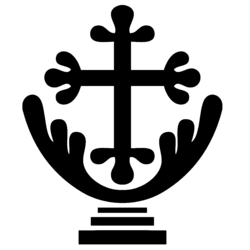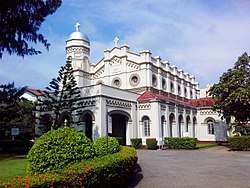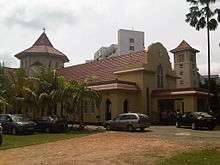Church of Ceylon
The Church of Ceylon is the Anglican Church in Sri Lanka, as an extra-provincial diocese of the Archbishop of Canterbury. It was established with the appointment of its first Bishop, James Chapman in 1845 as the Bishop of Colombo. Until 1950 it consisted only of the Diocese of Colombo but a second diocese was established at Kurunegala in that year.
| Church of Ceylon | |
|---|---|
 Anuradhapura cross, featuring in church logos | |
| Primate | Justin Welby, Archbishop of Canterbury |
| Language | English, Sinhalese & Tamil |
| Headquarters | Colombo, Sri Lanka |
| Territory | Sri Lanka |
| Origin | 1815[1] |
| Recognition | Church of England |
| Members | 50,000 |
| Official website | http://www.dioceseofcolombo.lk/ http://www.dioceseofkurunegala.com |


The Dioceses of Colombo and Kurunegala
The first services were held on the island in 1796 and missionaries were sent to Ceylon to begin work in 1818.[2] The Church now has two dioceses, one in Colombo (covering the Western, Southern, Eastern, Northern and Uva provinces and Ratnapura, Nuwara Eliya and Puttalam districts) and the other in Kurunegala (covering Kurunegala, Kandy, Matale and Kegalla, Anuradapura, Polonnaruwa, districts). The Diocese of Colombo was founded in 1845 and the Diocese of Kurunegala in 1950.[2]
The Bishop of Calcutta was the Metropolitan Bishop of India and Ceylon from 10 October 1835. In 1930 Ceylon was included in the Church of India, Burma and Ceylon (from 1948 the Church of India, Pakistan, Burma, and Ceylon) until 1970. In 1970, the Church of the Province of Myanmar, the Church of Ceylon and the Church of Pakistan were separated from the CIBC (and the province of Calcutta).
There has been movement for the amalgamation of traditional Protestant Churches (including Church of Ceylon, Methodist Church, Lanka Baptist Sangamaya, Salvation Army, Presbyterian Church of Sri Lanka and the Christian Reformed Church of Sri Lanka (formerly the Dutch Reformed Church) and the Jaffna Diocese of the Church of South India into one body, namely the Church of Sri Lanka.
The Bishop of Colombo, Dhiloraj Canagasabey has under him four archdeaconries, namely, Colombo, Galle, Jaffna and Upcountry and East. Keerthisiri Fernando the 6th Bishop of Kurunegala has one archdeaconry.
The Church of Ceylon with around 50,000 members,[3] is the second largest group of Christians in Sri Lanka, after the Roman Catholic Church with 1,600,000 members.
Hymn for Ceylon
In the early 20th century an Anglican missionary, W. S. Senior arrived in Ceylon to work with the Church Missionary Society. He was Vice-Principal of Trinity College, Kandy for many years and spent three decades in the country.[4] W. S. Senior wrote the 'Hymn for Ceylon,' sung to this day in churches on the island. The music for parts of this hymn was composed in 1950 by the leading Sri Lankan folk musician Deva Suriya Sena.[5]
See also
- Christianity in Sri Lanka
- Bishop of Colombo
- Bishop of Kurunegala
- Cathedral of Christ the Living Saviour
- Cathedral of Christ the King, Kurunegala
- St. Paul's Church, Kandy
- Trinity College Chapel, Kandy
- Church of Ceylon church buildings in Sri Lanka
- Theological College of Lanka
References
- "History of the Church of Ceylon Diocese of Colombo".
- "History – Church of Ceylon (Anglican Communion)". Retrieved 2009-08-02.
- "Church of Ceylon — World Council of Churches". www.oikoumene.org.
- Herby Jayasuriya. "Two different views of Ceylon by two English Missionaries". Daily News, Sri Lanka. Archived from the original on 2011-06-05. Retrieved 2009-08-02.
- Shehan Silva (23 May 2009). "Hymn for Sri Lanka – Ceylon (Trilingual)" – via YouTube.
External links
- Diocese of Colombo
- The Church of Ceylon (Anglican Communion)
- Anglican Church of Ceylon News
- Worship Resources including a Prayer for Sri Lanka written by Metropolitan Lakdasa de Mel
- The Church of Ceylon – World Council of Churches website
- A photo selection of Parishes of the Church of Ceylon
- Hymn
- A Sinhalese Hymn filmed at Holy Emmanuel Church, Moratuwa – Anglican Church of Ceylon on YouTube
- The Hymn for Ceylon – Trilingual (Anglican Communion)
- Publications
- One hundred years in Ceylon, or, The centenary volume of the Church Missionary Society in Ceylon, 1818–1918 (1922) Author: Balding, John William Madras: Printed at the Diocesan Press.
- The Church of Ceylon – her faith and mission Published in 1945, Printed at the Daily News Press by Bernard de Silva for the Church of Ceylon.
- The Church of Ceylon: A history, 1945–1995 Editor: Medis, Frederick Published for the Diocese of Colombo.
